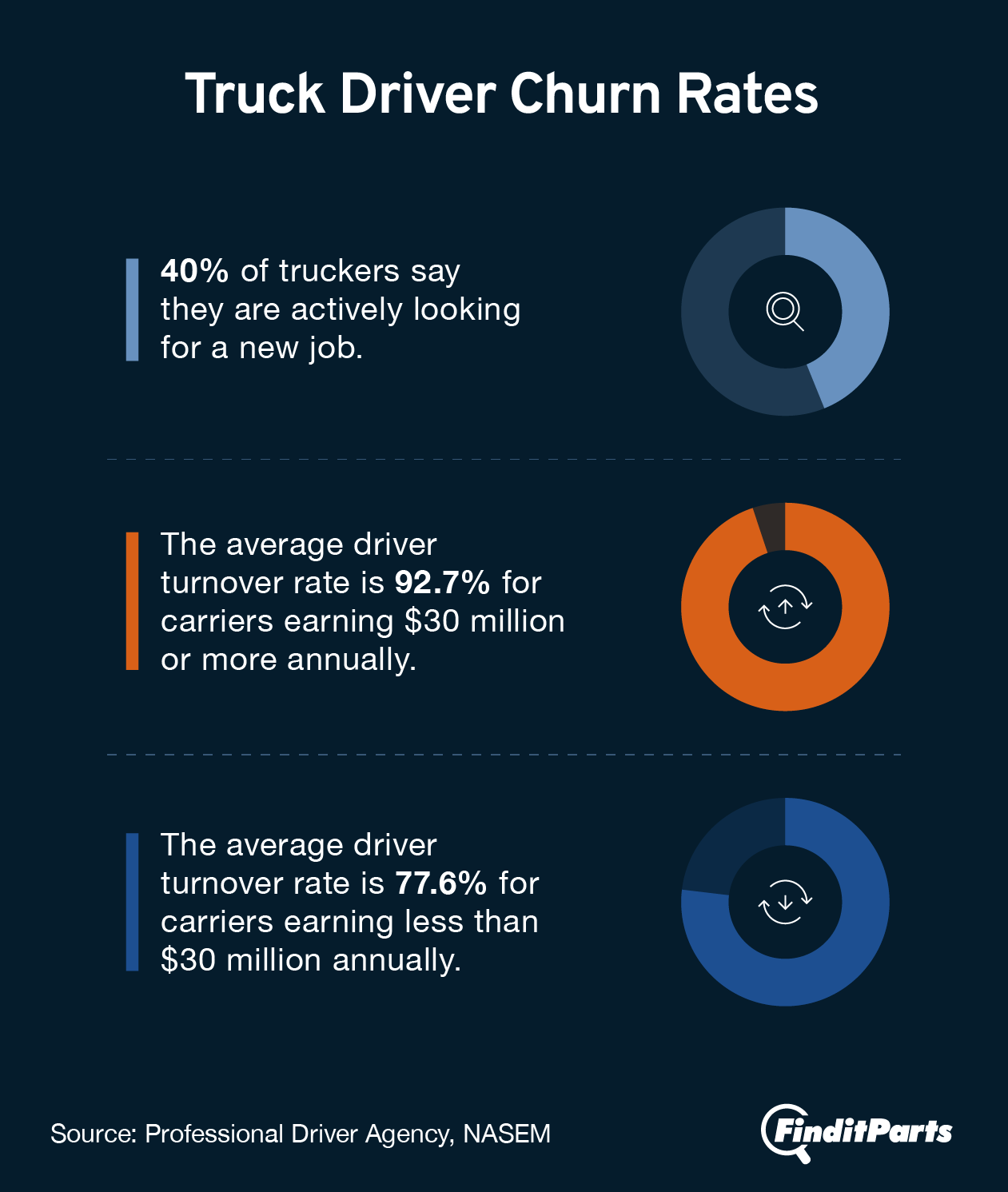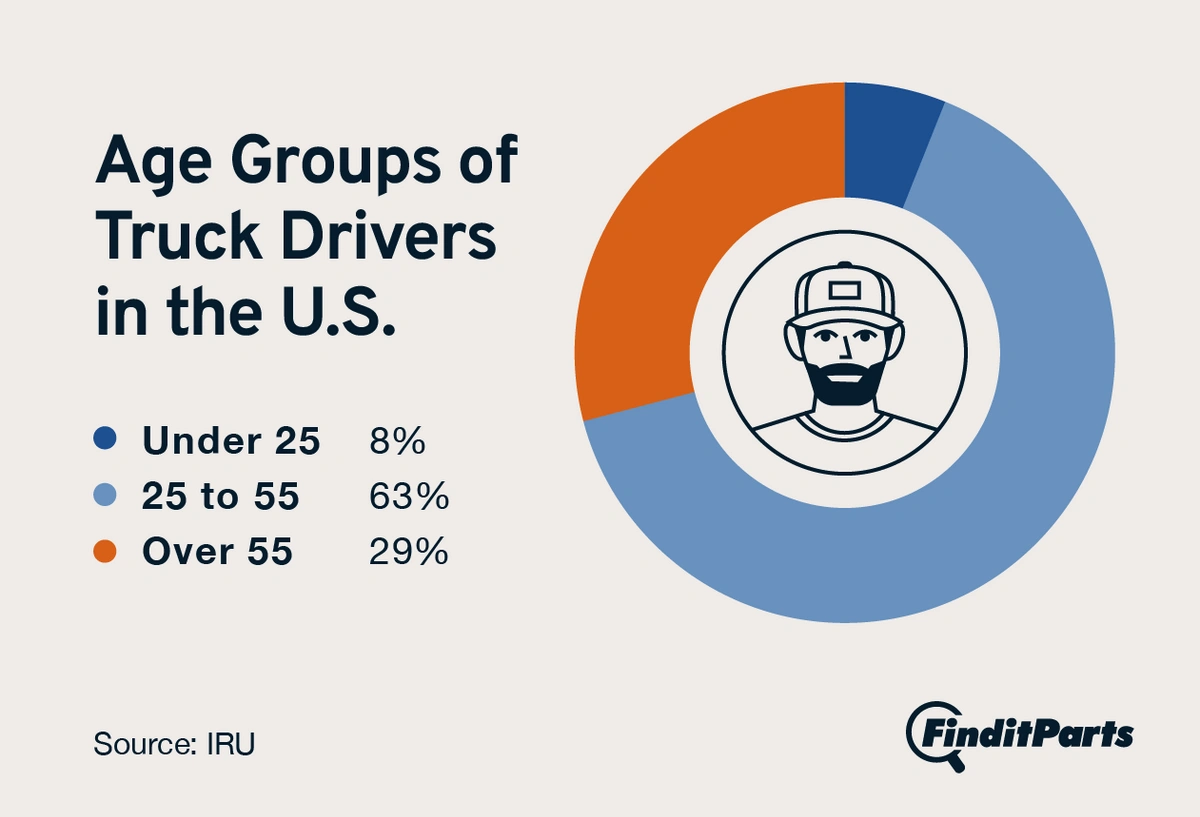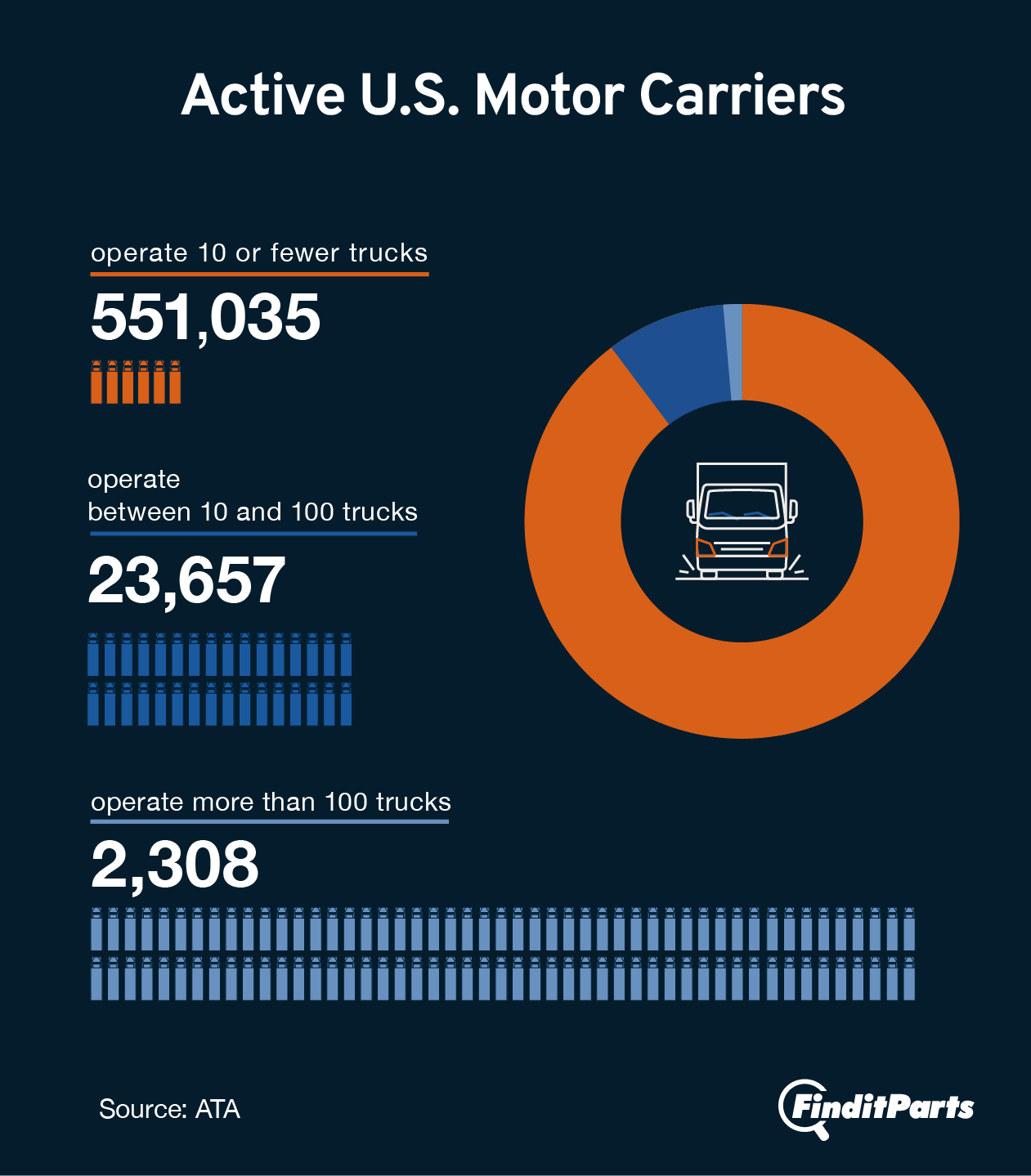Need help? We're here!
(888) 312-8812 Login SignupTruck Driver Shortage Statistics: 49 Trends to Know for 2025
January 23, 2025

Trucking plays an essential role in our economy, enabling the movement of goods and ensuring supply chains remain operational. In fact, according to American Trucking Associations (ATA), trucks move over 70% of all freight in the U.S.
However, a significant hurdle has arisen: a truck driver shortage. In the last few years, a lack of drivers has threatened to cause major business interruptions across a broad variety of industries. As reported by Motive Technologies, Inc., the 2023 holiday season saw slower shipment turnaround times and other logistical challenges. Now, as 2024 comes to a close, experts brace for continued issues with supply chain volatility.
To get a better understanding of the impact, we’ve rounded up the latest truck driver shortage statistics into one accessible resource below. We approach the issue from all angles, including workforce challenges, shifting market dynamics, operational costs, and more. By presenting these insights, we aim to provide a clearer picture of the trends shaping trucking today.
Table of Contents:
- Key Trucking Shortage Statistics
- Trucking Workforce Statistics
- Trucking Demand vs. Capacity Statistics
- Equipment and Maintenance Statistics
- The Global Truck Driver Shortage
- Additional Freight Facts
- Underlying Causes of the Trucking Shortage
- Impact of the Shortage on Truckers and Businesses
- Unpacking the Driver Shortage Debate
Key Trucking Shortage Statistics
1. The truck driver shortage is most severe in the longer-haul market. (American Trucking Associations)
2. Truck driver job satisfaction is in the bottom 10% of all careers. (CareerExplorer)
3. The top five concerns among commercial truck drivers are the economy, a lack of parking, rising fuel prices, the shortage of truck drivers, and their compensation. (American Transportation Research Institute)
4. The truck driver shortage in the U.S. is expected to go from a shortage of 80,500 drivers in 2011 to 162,000 by 2030. (Statista)
5. Employment of truck drivers is projected to grow by 5% from 2023 to 2033. (U.S. Bureau of Labor Statistics)
Trucking Workforce Statistics
The average truck driver is a male in his 40s. Low job satisfaction and high turnover rates make trucking a less-than-appealing option for new talent or underrepresented demographics. Now, with more and more drivers nearing retirement age, the industry is struggling to fill their shoes.
6. As of 2023, the U.S. trucking industry employs approximately 3.55 million professional drivers, contributing to a total of 8.5 million individuals working in industry-related jobs. (ATA)
7. Only 12% of truck drivers are below 25, and just 6% are women. (International Road Transport Union)
8. According to a recent survey conducted by the Owner-Operator Independent Drivers Association, 32% of self-employed truck drivers (also known as owner-operators) are military veterans. (OOIDA)
9. The average age of a truck driver is 46. (U.S. Bureau of Labor Statistics)
10. Approximately 144,000 truck drivers are over 65 years old. (U.S. Bureau of Labor Statistics)
11. The average age of a new truck driver is 35. (ATA)
12. The average target retirement age for an owner-operator is 69. (OOIDA)
13. 40% of truckers say they are actively looking for a new job. (People Data Analytics)
14. The average driver turnover rate from 1996 to 2023 was 92.7% for long-distance carriers earning $30 million or more annually and 77.6% for small carriers earning less. (NASEM)
15. Approximately 240,300 job openings for truck drivers are projected each year. (U.S. Bureau of Labor Statistics)
16. Over the next 10 years, nearly 1.2 million new drivers will be needed in order to replace retiring drivers and sustain industry growth. (ATA)
Trucking Demand vs. Capacity Statistics
With increased e-commerce activity and the associated normalization of speedy delivery, there was a post-pandemic spike in demand for the trucking industry—but drivers are still in short supply.
17. E-commerce sales in the U.S. reached a whopping $1.12 trillion in 2023. (U.S. Department of Commerce)
18. E-commerce represented 22% of all retail sales in the U.S. in 2023, up from 21.2% in 2022. (U.S. Department of Commerce)
19. As of mid-2024, the trucking industry's capacity utilization stood at around 88%, indicating a slight underutilization due to increased fleet sizes and fluctuating demand. (Heavy Duty Trucking)
20. In the third quarter of 2024, truckload spot rates experienced a year-over-year increase of 5.8%, reflecting tightening capacity and rising demand. (RXO)
Equipment and Maintenance Statistics
With no shortage of work to be done, fewer drivers are logging miles. Behind the scenes, the average age of fleet vehicles is increasing, leading to decreased efficiency. The rising costs of fuel, replacement parts, and insurance premiums also place strain on the trucking industry.
21. Single-unit and combination trucks traveled 331.27 billion miles in one year. (ATA)
22. 69% of fleet professionals surveyed reported the average age of their trucks had exceeded their normal replacement cycle, and 29% said the average age of a fleet vehicle is over 10 years. (National Truck Equipment Association)
23. Truck repair and maintenance expenses rose by 12% in just one year, bringing them to $0.20 per mile. This is driven by parts shortages and increased technician labor rates. (ATRI)
24. On average, operational costs for trucking companies rose by 6% from 2023 to 2024, with insurance premiums increasing by 12.5%. (Risk Placement Services)
25. The federal tax on diesel fuel is 24.4 cents per gallon. (U.S. Energy Information Administration)
26. Over the course of just one year, commercial trucks paid $36.48 billion in federal and state fuel taxes. (ATA)
The trucking industry isn’t just about driving—it’s navigating a full-blown obstacle course. Rising fuel prices (which jumped 26% year-over-year in 2023) and skyrocketing equipment costs are squeezing already thin profit margins. Maintenance isn’t any kinder, with tire costs alone seeing a 15% increase in the past year. These costs don’t just dent wallets; they deter new drivers and push existing ones out of the industry. It’s like asking someone to take on a job where they pay you to work. To top it off, these expenses trickle down to higher freight rates, disrupting the supply chain. The result? A vicious cycle that keeps the trucking shortage stuck in first gear.
—John Conte, VP of Supply Chain at FinditParts
The Global Truck Driver Shortage
The United States is not the only country dealing with a truck driver shortage. Inflation and monetary policies have impacted consumption and investment across the world, leading to reduced demand overall. Where else are truck drivers in demand? Let’s take a closer look.
27. The global truck driver shortage is expected to double by 2028. (International Road Transport Union)
28. Across 36 countries, there are more than 3 million unfilled truck driver positions. (IRU)
29. Over 50% of companies across the world reported facing “severe or very severe” difficulties filling truck driver positions. (IRU)
30. 74% of trucking companies in Mexico and 65% in Russia reported “severe or very severe” difficulties hiring truck drivers. (IRU)
31. On average, Uzbekistan has the youngest truck drivers, while the United States, Russia, and Europe have the oldest. (IRU)
32. Financial barriers are another contributing factor. In France, the average cost to obtain a truck driver’s license and certificate is over three times the minimum monthly wage. (IRU)
33. The global trucking industry’s real revenue growth was down to 6% in 2022 versus 10.5% in 2021. The trucking industry’s year-over-year real revenue growth is expected to fall even further to 3% by the end of 2024. (IRU)
Additional Freight Facts
From agriculture to retail and manufacturing, there’s no denying the indispensable role of interstate trucking in supply chains nationwide. How will a truck driver shortage impact the greater industry, and how do existing economic and geographic conditions affect the industry overall? Let’s take a look.
34. In 2022, the trucking industry generated $940.8 billion in gross freight revenues, accounting for 80.7% of the U.S. transportation industry. (ATA)
35. Trucks move approximately 72.6% of the nation's freight by weight, underscoring their critical role in the retail supply chain. (ATA)
36. 11.3 billion tons of freight were transported domestically last year. This number is expected to balloon to 14.2 billion tons by 2034. (ATA)
37. There are over 577,000 active motor carriers—95.5% of them operate fleets of 10 or fewer trucks. (ATA)
38. Over 90% of truckload carriers raised driver pay in 2021. (ATA)
39. Truck driver wages increased by 7.6% in 2023. (Risk Placement Services)
40. Regional truck drivers earn an average of $75,877 per year, or $36 per hour. (ZipRecruiter)
41. On average, local truck drivers make $63,020 per year, or $30 per hour. (ZipRecruiter)
42. Where are truck drivers needed the most? Ohio, Iowa, Delaware, Pennsylvania, and Kentucky are the states with the highest number of job openings for truckers. (Nationwide Transport Services)
43. Alaska is the state with the highest average truck driver salary ($65,870 per year for heavy trucks and $55,810 per year for light trucks), while West Virginia has the lowest ($48,460 per year for heavy trucks and $38,960 per year for light trucks). (FinditParts)
44. Texas employs more heavy truck drivers than any other state (212,770). (U.S. Bureau of Labor Statistics)
45. Texas also has the most large truck crashes on the roads of any U.S. state. (Federal Motor Carrier Safety Administration)
46. Alaska has the least truck crashes among the states. (FMCSA)
47. California is home to the most dangerous roads for trucks. (FinditParts)
48. Vermont is home to the least dangerous roads for trucks. (FinditParts)
49. In 2023, trucks transported 66.5% of the value of surface trade between the U.S. and Canada and 84.5% of the value of surface trade between the U.S. and Mexico. (ATA)
Underlying Causes of the Trucking Shortage
Is there a shortage of truck drivers, or is the problem actually about retention? The truck driver shortage is a controversial topic, with a range of different perspectives on its underlying causes.
Some experts argue that the issue is not a shortage of truck drivers but rather high turnover rates and retention challenges. In fact, a recent study by the National Academies of Sciences, Engineering, and Medicine disputes ATA's truck driver shortage claims, highlighting how pay and working conditions significantly impact driver retention rates.
Likewise, a recent debate at FreightWaves’ F3: Future of Freight Festival highlighted that the trucking industry might be facing a driver retention problem rather than a shortage. The Owner-Operator Independent Drivers Association echoed this sentiment.
The real answer lies in a combination of workforce and industry challenges:
- Aging workforce: As more experienced drivers retire, the industry struggles to attract enough younger workers to take their place. The ATA reports that the average truck driver in the U.S. is over 46, while the average age of a new trainee driver entering the profession is 35 years old.
- Difficult work-life balance: According to the International Journal of Physical Distribution & Logistics Management, longer hauls have become more common, contributing to fatigue, burnout, and job dissatisfaction among truckers who miss spending time with loved ones.
- High turnover rates: The International Journal of Physical Distribution & Logistics Management also reports that truck drivers often leave their jobs due to demanding schedules, dissatisfaction with pay, or a general desire to seek better opportunities.
- Regulatory and licensing challenges: Ever-shifting requirements for licensing, hours of service, and safety standards might slow the entry of new drivers, creating a bottleneck in workforce replenishment. As discussed by the PrePass Safety Alliance, Current regulatory changes up for discussion include the Drug & Alcohol Clearinghouse and the Electronic Logging Device (ELD) mandate.
- Economic cycles: Some analyses indicate that market dynamics, such as freight demand fluctuations and economic cycles, are influencing driver availability. For example, Trucking Dive recently covered how the driver shortage improved in 2023 due to a period of decreased demand, not because recruiting drivers got any easier.
The trucking shortage isn’t just about fewer drivers; it’s about systemic issues hitting from all angles—aging workforce, regulatory challenges, and a work-life balance that feels more like work-work. Imagine spending weeks on the road only to deal with high turnover rates and economic cycles that make pay unpredictable. Add to that the average trucker age nearing 50, and we’re not exactly inspiring Gen Z to hop behind the wheel. Fixing this shortage is like fixing a truck with too many leaks—you can’t just patch one hole and call it a day. It takes a holistic overhaul of pay, conditions, and incentives to truly get the wheels turning again.
—John Conte, VP of Supply Chain at FinditParts
Impact of the Shortage on Truckers and Businesses
From job dissatisfaction to higher fuel costs, the truck driver shortage statistics we’ve covered significantly impact truckers and the businesses they transport goods for.
As the pool of candidates grows smaller and smaller, many trucking companies are spending more on recruitment costs. They’re also raising wages or offering other incentives in an attempt to attract and retain drivers.
Unfulfilled deliveries and other contract violations can damage client relationships. Disruptions like these create a ripple effect across the supply chain, eventually leading to higher prices for consumers.
As for future trends in the heavy-duty industry, there are autonomous vehicles and other technological innovations on the horizon that aim to alleviate driver shortages. However, these potential solutions are hotly debated, with many people expressing concerns about feasibility and safety. A 2024 self-driving trucks survey by our team at FinditParts revealed that the majority of Americans (62%) believe autonomous trucks will make driving on the highway more dangerous.
Unpacking the Driver Shortage Debate
While claims of a truck driver shortage are widespread, there are many elements to consider as we strive to fully understand the industry's challenges.
When it comes to statistics on truck driver shortages, inconsistencies in data collection and interpretation are an oft-overlooked nuance. Factors like regional differences, types of freight, and company-specific issues may not be fully accounted for, leading to overgeneralized conclusions.
Looking back on the truck driver shortage, 2024 was a year of digging to the core of the problem. Repair costs for aging fleet vehicles were among the contributing factors. As we look to the future, FinditParts will have no shortage of the long-haul trucking parts you need. As always, we’re committed to making your journey as smooth as possible.
Related Posts
- Trucking Industry Statistics: 28 Trends to Know
- Trucking Costs: 43 Stats for Fleet Owners and Drivers
- Truck Driver Salaries: The 10 States With the Highest Average Pay
- Self-Driving Trucks: More Than 90% of Americans Have Concerns
- Semi Truck Blind Spots: 95% of Americans Can't Identify Them
- Truck Accident Statistics: Semi Crash Trends & Insights






